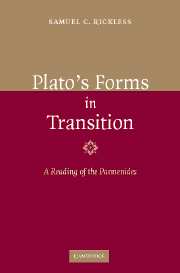Book contents
- Frontmatter
- Contents
- Preface
- List of abbreviations
- Introduction
- Chapter 1 The theory of forms
- Chapter 2 The theory criticized
- Chapter 3 The theory modified: methodology
- Chapter 4 The First Deduction
- Chapter 5 The Second Deduction
- Chapter 6 From the Appendix to the Fourth Deduction
- Chapter 7 From the Fifth to the Eighth Deduction
- Conclusion
- References
- Index of forms discussed
- Index of Deductions
- Index of passages cited
- General index
Chapter 7 - From the Fifth to the Eighth Deduction
Published online by Cambridge University Press: 22 September 2009
- Frontmatter
- Contents
- Preface
- List of abbreviations
- Introduction
- Chapter 1 The theory of forms
- Chapter 2 The theory criticized
- Chapter 3 The theory modified: methodology
- Chapter 4 The First Deduction
- Chapter 5 The Second Deduction
- Chapter 6 From the Appendix to the Fourth Deduction
- Chapter 7 From the Fifth to the Eighth Deduction
- Conclusion
- References
- Index of forms discussed
- Index of Deductions
- Index of passages cited
- General index
Summary
The last four Deductions take up no more than six or so Stephanus pages (160b5–166c5). Parmenides has lost interest in establishing his results in as virtuosic a fashion as is displayed in the first two Deductions. Still, these Deductions are important to the plan of the dialogue.
THE FIFTH DEDUCTION
D5A1 (160b5–d2)
D5A1 establishes two conclusions, (C1) that if the one is not, then the one is different from the others, and (C2) that if the one is not, then we have knowledge of the one.
Assume (P1) that in saying “the one is not” what we are saying is not is contrary to the not-one. Taken on its own, P1 entails (L1) that if the one is not, then the one and the not-one are contraries. Now, by D2A11P4, the others are those that are not one. Taken on its own, D2A11P4 entails (L2) that the others are the not-one. Hence, by L1 and L2, if the one is not, then the one and the others are contraries. Now, by D4A3P2, if X and Y are contraries, then X is not the same as Y, and, by D2A4P1, if X is not the same as Y, then X is different from Y. Taken together, then, D4A3P2 and D2A4P1 entail (L3) that if X and Y are contraries, then X is different from Y (and hence, if the one and the others are contraries, then the one is different from the others).
- Type
- Chapter
- Information
- Plato's Forms in TransitionA Reading of the Parmenides, pp. 212 - 239Publisher: Cambridge University PressPrint publication year: 2006



